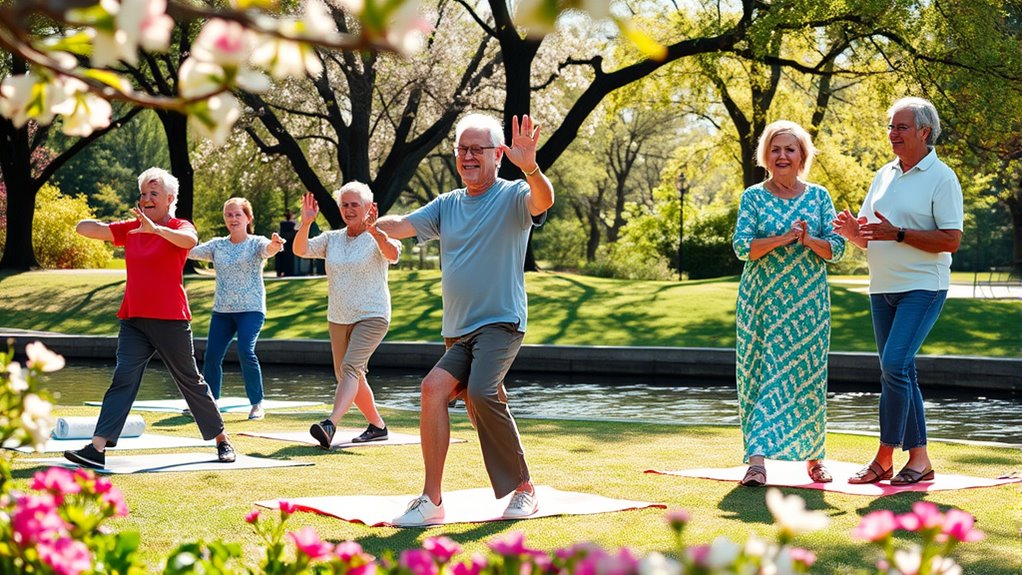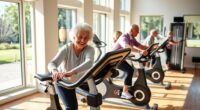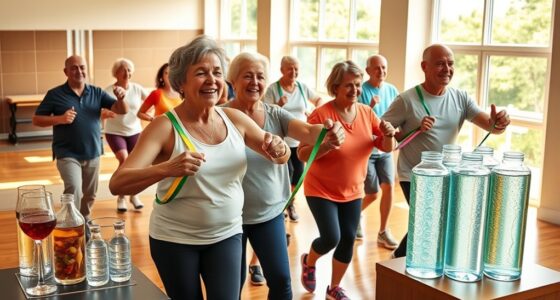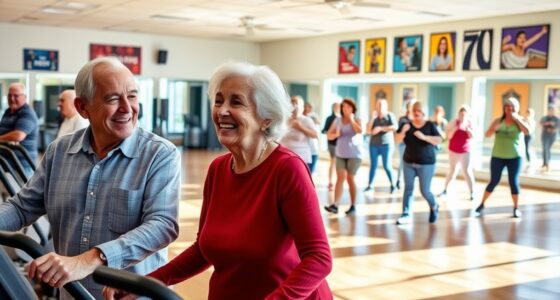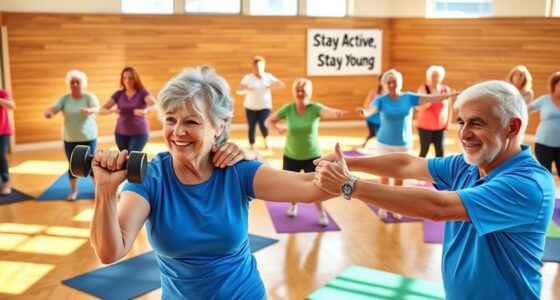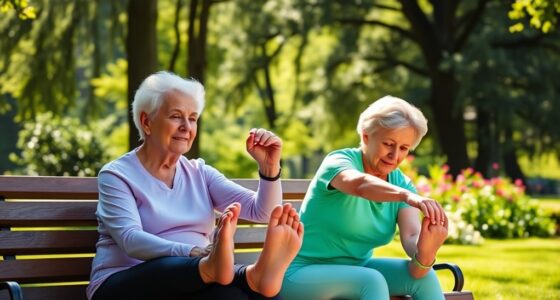To stay strong and vibrant, you need to engage in regular exercise, like swimming or tai chi. Aim for at least 150 minutes of moderate activity each week, plus two days of strength training. Low-impact exercises are great for joint health, while balance and mobility exercises help prevent falls. Incorporating these activities into your daily routine can boost your overall well-being. Discover more ways to keep active and enhance your quality of life.
Key Takeaways
- Engage in at least 150 minutes of moderate-intensity aerobic activities weekly, such as walking, swimming, or cycling, to enhance cardiovascular health.
- Incorporate two days of muscle-strengthening exercises, like wall push-ups and calf raises, to improve strength and reduce fall risk.
- Practice balance exercises three times a week, including tai chi or yoga, to enhance stability and coordination, promoting independence.
- Participate in low-impact group exercise classes to foster social connections, boost mental well-being, and make physical activity enjoyable.
- Include flexibility and mobility exercises, like hip rotations and ankle circles, to maintain joint health and enhance overall functional fitness.
Health Benefits of Regular Exercise for Seniors
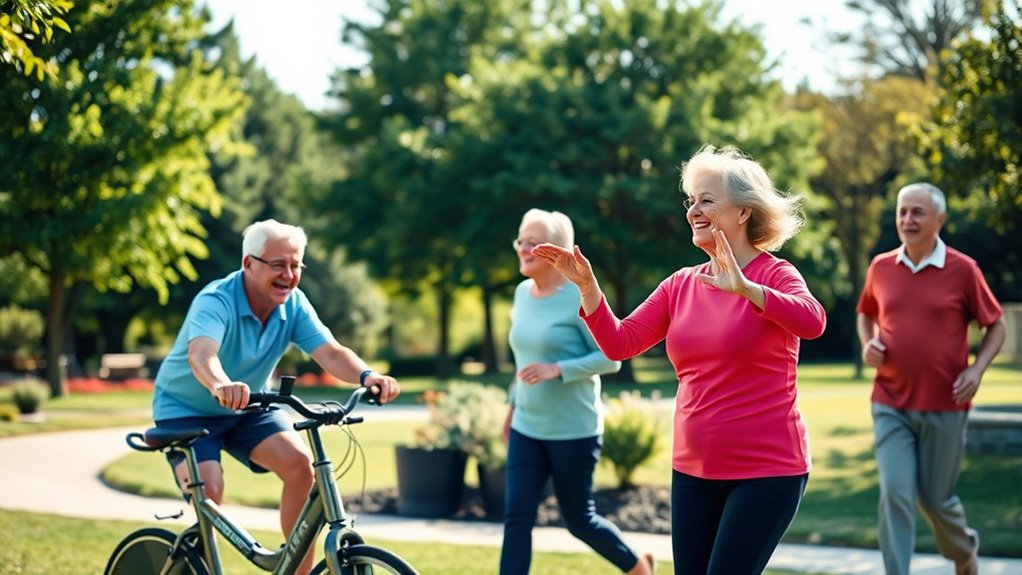
The health benefits of exercise are profound, especially for seniors. It notably reduces the risk of chronic diseases like heart disease and diabetes, enhancing your overall physical health. Additionally, regular physical activity can lead to improved home safety measures, which is essential for preventing accidents and ensuring a secure living environment for seniors. Engaging in regular exercise also supports emotional and psychological growth, which is crucial for maintaining mental well-being as one ages. Furthermore, participating in physical activities can help lower the risk of tick-borne diseases, particularly in outdoor environments. Regular exercise can also enhance filial responsibility, allowing seniors to maintain independence and avoid placing undue financial burdens on their families.
By staying active, you boost your energy levels and improve sleep patterns, which helps combat fatigue. Additionally, exercise enhances balance and coordination, reducing the likelihood of falls by nearly 23%. This is essential, considering one in four older Americans experience falls annually.
Staying active boosts energy, improves sleep, and reduces fall risk, essential for the well-being of older adults.
Most importantly, regular physical activity promotes mental health, leading to a better quality of life and a nearly 50% reduced risk of Alzheimer’s disease and dementia. Furthermore, engaging in exercise can provide a valuable opportunity for social interaction and support, which is crucial for emotional well-being in seniors.
Recommended Exercise Frequency for Older Adults
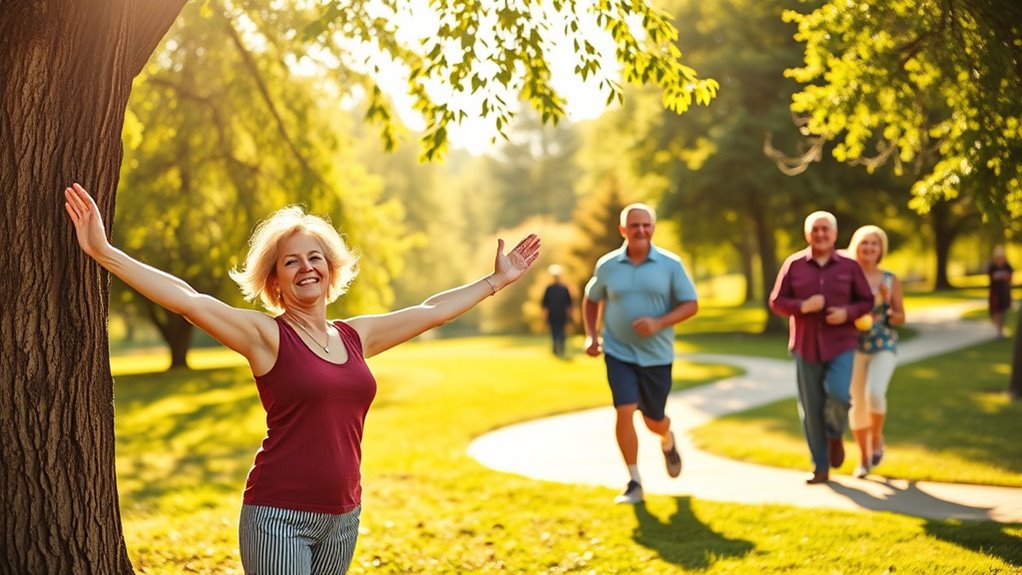
To maintain ideal health and fitness, older adults should aim for at least 150 minutes of moderate-intensity aerobic activity each week. This level of exercise promotes cardiovascular health and overall well-being. Engaging in sustainable fashion practices can also encourage a lifestyle that values health and wellness. Additionally, regular physical activity can help reduce the risk of breast cancer by promoting a healthy weight and hormonal balance. Regular participation in mindfulness practices can also enhance mental health and emotional well-being. Creating a supportive environment at home can further encourage seniors to engage in these activities.
If you’re up for more intensity, consider 75 minutes of vigorous activity, like jogging or swimming. Additionally, incorporate at least two days of muscle-strengthening exercises to enhance muscle mass and strength.
Balance exercises are essential too; practicing them three times a week can greatly aid in fall prevention, an important consideration for seniors. Regular activity not only improves physical health but also helps combat feelings of running dry, which can significantly impact mental well-being.
Best Types of Exercises for Seniors
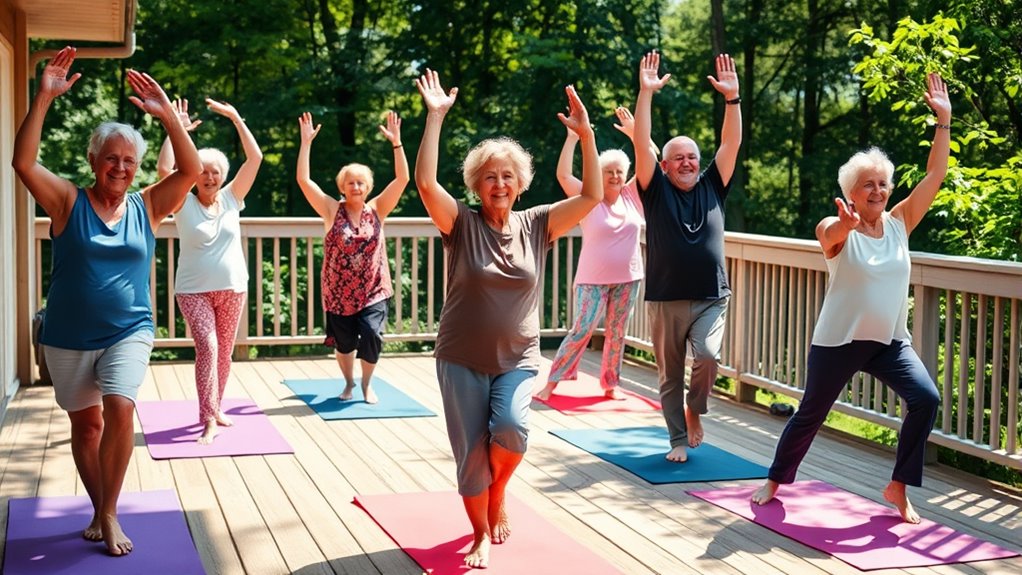
When it comes to staying active, you’ll find that low-impact cardio options like swimming and walking are perfect for your joints while boosting your heart health. Engaging in community events can also encourage social connections and motivate you to maintain a regular activity schedule. Don’t overlook strength and balance training, which play an essential role in maintaining muscle mass and preventing falls; incorporating multi-functional furniture can facilitate easier movement and organization in your home. Additionally, participating in outdoor activities can benefit from portable camping toilets that ensure comfort and convenience while enjoying nature. It’s important to find ways to create a harmonious co-parenting environment that supports your well-being and encourages physical activity. Finally, incorporating flexibility and mobility exercises will help you move comfortably and freely in your daily life. Additionally, engaging in outdoor activities can provide essential items for survival while promoting overall well-being.
Low-Impact Cardio Options
Low-impact cardio options are perfect for seniors who want to stay active without putting too much strain on their joints. Activities like swimming and cycling help improve cardiovascular health while minimizing the risk of injury. National parks often provide scenic walking trails that are suitable for low-impact exercise. Additionally, engaging in outdoor activities can help seniors discover local water sources for hydration during their workouts. Incorporating themed breakfasts can also encourage seniors to socialize and maintain a balanced diet. Regular participation in these activities can enhance overall wellness and may contribute to improved fuel efficiency in daily routines.
Joining water aerobics classes or engaging in short, 15-minute walks can greatly enhance your heart health and contribute to the recommended 150 minutes of moderate activity per week. Incorporating a variety of whole foods into your diet can further support your overall health and energy levels for these activities. Group exercise classes, such as low-impact Zumba or dance, not only provide great aerobic exercise but also foster social interaction, boosting your mental well-being.
Strength and Balance Training
While low-impact cardio options help maintain cardiovascular health, incorporating strength and balance training into your routine is key for overall mobility and safety. Engaging in these exercises can also aid in processing good grief, which is important for emotional health as you age. These exercises not only enhance muscle mass but also greatly reduce fall risk, as cognitive decline can contribute to instability and accidents. Engaging in regular physical activity can improve indoor air quality, which is essential for a healthy living environment as you age. It’s crucial to ensure that your exercise routine includes mineral-based sunscreen for protecting your skin during outdoor activities. Engage in strength and balance training at least twice a week to support your functional fitness and joint health. Additionally, including regular physical activity can enhance overall health and well-being as you age.
Here are some effective activities to include:
- Wall push-ups for upper body strength
- Calf raises to strengthen legs
- Standing from sitting to improve balance
- Walking heel-to-toe for stability
- Ankle circles to promote joint flexibility
Flexibility and Mobility Exercises
Flexibility and mobility exercises play an essential role in maintaining your independence as you age. Incorporating activities like neck stretches and shoulder rolls can relieve tension and improve your range of motion, making daily tasks easier. Engaging in pet therapy can also provide companionship and motivation, encouraging you to stay active and involved. Regularly checking and cleaning air purifier filters can significantly improve air quality, which is important for overall health.
Hip rotations and ankle circles enhance joint mobility, helping to reduce joint pain and discomfort. Regular balance exercises, such as standing up from a seated position and walking heel-to-toe, markedly enhance muscle strength and stability, reducing your risk of falls. Aim to engage in mobility exercises three times a week to support your agility and flexibility. This consistent practice not only promotes better posture and blood circulation but also contributes to your overall well-being, allowing you to enjoy life to the fullest. Additionally, engaging in music and movement activities can further enhance coordination and provide a joyful atmosphere for exercise.
Importance of Balance and Mobility Exercises
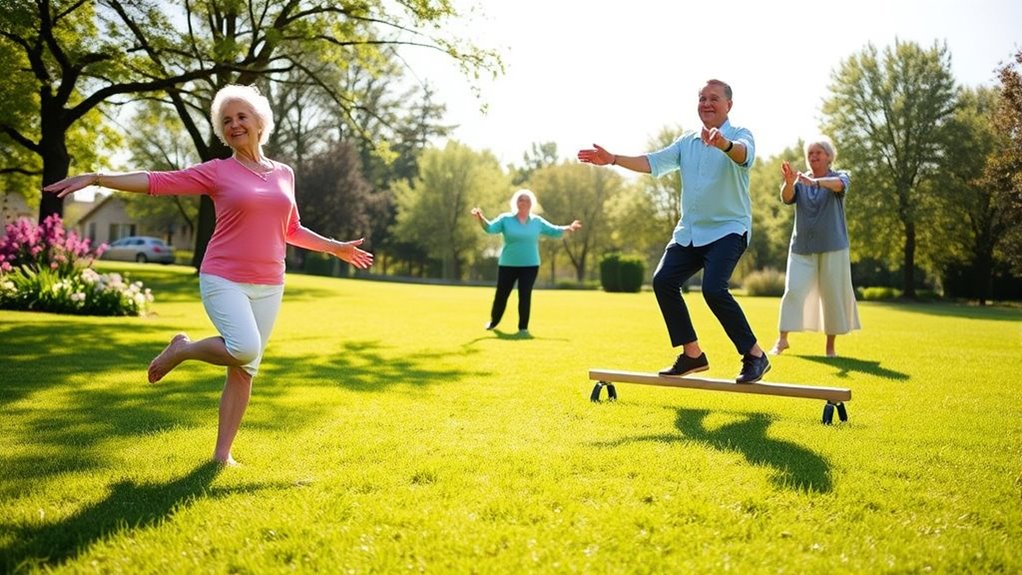
As you age, it’s common to experience a decline in balance, which can increase your risk of falls.
Incorporating balance and mobility exercises into your routine can greatly enhance your stability and confidence, making daily activities easier.
Decline in Balance
Maintaining balance becomes increasingly challenging as you age, making it essential to engage in balance and mobility exercises. These activities can greatly enhance your stability and reduce the risk of falls.
Here are some key benefits of including balance and mobility exercises in your fitness routine:
- Strengthen stabilizing muscles for better stability
- Improve coordination and body awareness
- Increase agility and flexibility for everyday tasks
- Incorporate tai chi and heel-to-toe walking easily
- Boost confidence in movement and independence
Mobility Exercise Benefits
While you mightn’t think about it often, incorporating mobility exercises into your routine can greatly enhance your overall well-being.
These exercises help improve balance and enhance flexibility, which are essential for staying active and independent. By regularly engaging in mobility exercises, you strengthen stabilizing muscles, considerably reducing the risk of falls—a concern for 1 in 4 older Americans each year.
Practicing these engaging activities at least three times a week can maintain mobility and boost your confidence in movement. Furthermore, staying consistent with mobility exercises helps prevent debilitating conditions, allowing you to enjoy a higher quality of life.
Embrace these benefits, and you’ll find yourself participating more fully in social activities and community engagements.
Fall Prevention Strategies
To prevent falls, it’s essential to prioritize balance and mobility exercises in your routine.
With 1 in 4 older Americans experiencing falls annually, implementing effective fall prevention strategies can make a significant difference.
Consider these key exercises:
- Balance Exercises: Engage in activities that enhance stability and coordination.
- Mobility Exercises: Incorporate hip rotations and ankle circles to maintain agility.
- Strengthening Exercises: Focus on your back, abdomen, and leg muscles for better balance.
- Tai Chi: This ancient practice enhances balance while promoting mental well-being.
- Yoga: Improve flexibility and mindfulness, reducing the likelihood of falls.
Strength Training to Enhance Independence

Strength training empowers seniors to enhance their independence and overall well-being. By engaging in regular physical exercise, you can improve muscle strength and balance, reducing the risk of falls by 23%. This not only fosters an active lifestyle but also helps maintain muscle mass and bone density, preventing osteoporosis and fractures. Incorporating bodyweight exercises, like wall push-ups and calf raises, promotes functional fitness for daily activities.
| Exercise | Benefits | Frequency |
|---|---|---|
| Wall Push-Ups | Improves upper body strength | 2-3 times a week |
| Calf Raises | Enhances lower leg strength | 2-3 times a week |
| Seated Leg Lifts | Boosts mobility | 2-3 times a week |
| Resistance Band Work | Increases overall strength | 2-3 times a week |
| Chair Squats | Supports balance and stability | 2-3 times a week |
Low-Impact Exercise Options for Joint Health
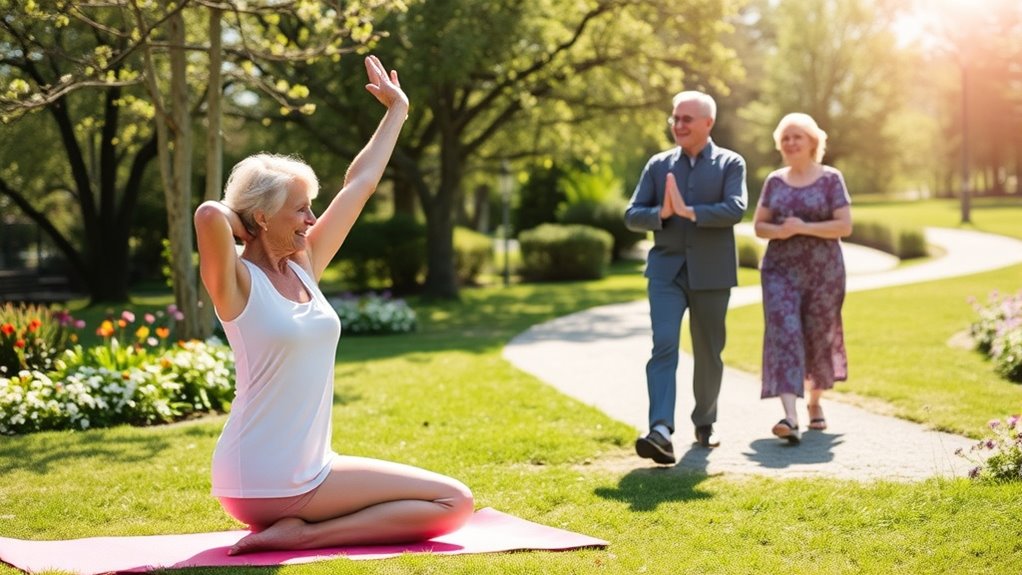
When it comes to maintaining joint health, low-impact exercises offer a fantastic way for seniors to stay active without putting undue stress on their bodies.
These activities not only promote mobility but also help alleviate joint pain and stiffness. Here are some great options to evaluate:
- Water aerobics: Provides resistance without impact, enhancing strength and flexibility.
- Chair yoga: Focuses on gentle movements that improve flexibility and core strength.
- Pilates: Emphasizes alignment and controlled movements to support joint health.
- Swimming: A full-body workout that’s easy on the joints.
- Cycling: Strengthens legs while keeping your joints safe.
Incorporating these low-impact exercises into your routine can also help maintain a healthy weight, further reducing stress on your joints.
Engaging in Cardiovascular Activities
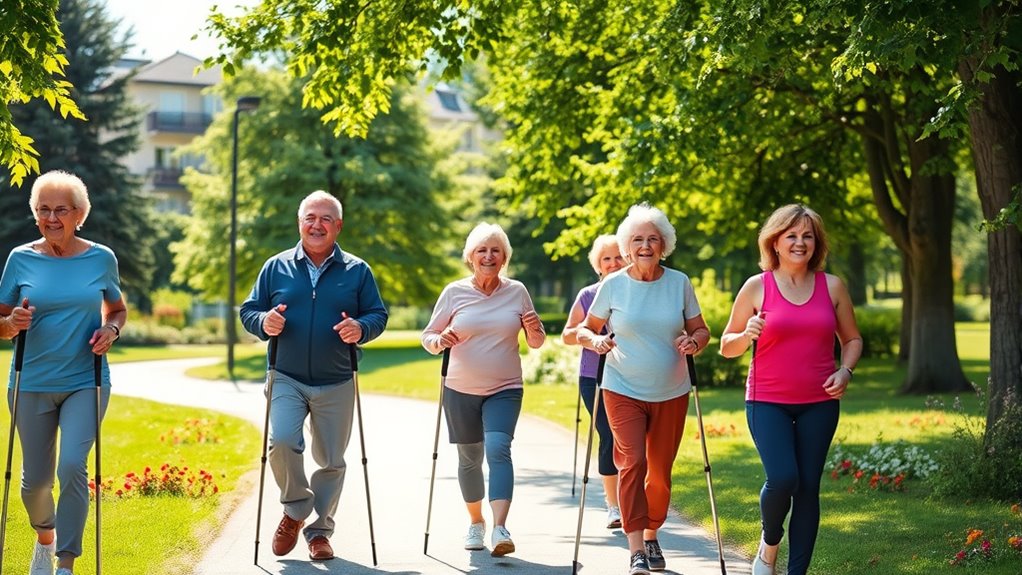
Maintaining joint health through low-impact exercises sets a solid foundation for engaging in cardiovascular activities. Seniors can greatly enhance heart health and overall endurance by participating in activities like walking, swimming, or cycling for at least 150 minutes each week.
Even short, 15-minute walks can boost your mood and energy levels. Low-impact options such as water aerobics are fantastic for minimizing stress on your joints while still offering cardiovascular benefits.
Joining group activities like pickleball or dance classes not only promotes fitness but also encourages social interaction, enhancing mental well-being.
Regular cardiovascular exercise can help reduce the risk of chronic diseases like heart disease and diabetes, promoting better metabolic function and overall health.
Incorporating Exercise Into Daily Routines
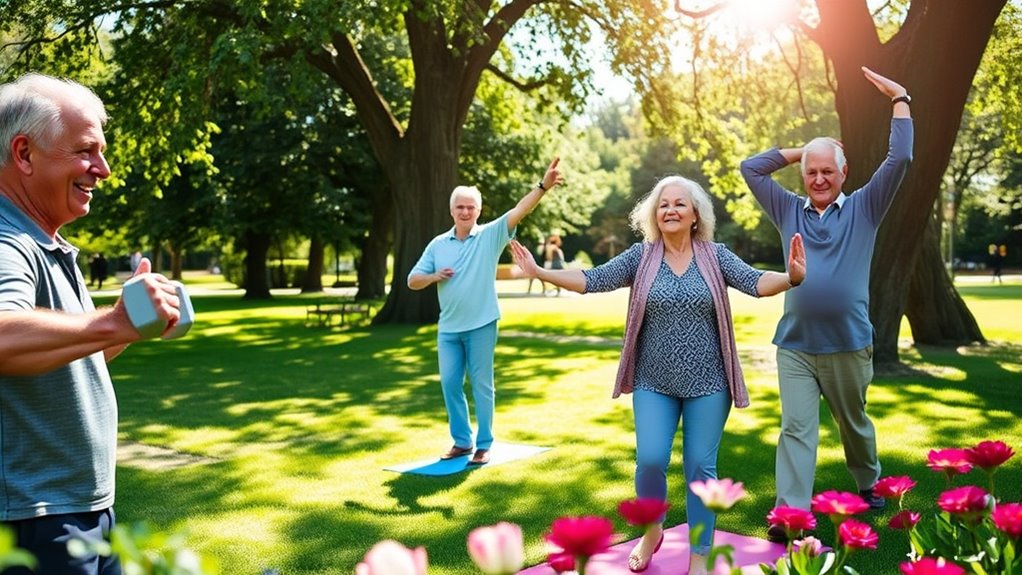
Incorporating exercise into your daily routine can be simple and effective, especially with short sessions of 10 to 15 minutes that fit easily into your schedule.
You can help maintain an active lifestyle by seamlessly blending exercises into your daily tasks. Here are some easy ways to incorporate exercise:
- Do calf raises while brushing your teeth.
- Stretch during TV commercials.
- Take short walks around your house.
- Join a walking group for social engagement.
- Set reminders or use fitness apps to track progress.
Frequently Asked Questions
What Is the Number One Exercise for Seniors?
The number one exercise for seniors is walking. It’s accessible and easy on your joints, making it perfect for maintaining your health.
Just 15 minutes a day can boost your mood, increase energy levels, and reduce the risk of chronic diseases. You can incorporate walking into your daily routine, whether it’s a leisurely stroll around your neighborhood or a brisk walk in the park.
Plus, it helps improve balance and coordination, essential for preventing falls.
How to Increase Stamina After 70?
To increase your stamina after 70, start by incorporating regular aerobic activities into your routine, aiming for at least 150 minutes weekly.
Include strength training exercises twice a week to help maintain muscle mass.
Don’t forget to practice balance and mobility exercises like tai chi or yoga three times a week.
Gradually boost the intensity of your workouts, stay hydrated, and eat a balanced diet to support your energy levels.
What Is the Best Physical Activity for Older Adults?
Imagine a gentle breeze guiding you along a sunlit path; that’s how invigorating the best physical activity can feel for you.
Walking is often considered the top choice for older adults, as it’s easy on the joints and boosts cardiovascular health.
Swimming and cycling are also great options, offering a revitalizing way to stay fit.
You’ll find that incorporating these activities into your routine not only strengthens your body but elevates your spirit, too.
What Is the Number 1 Exercise to Increase Balance in Seniors?
The number one exercise to increase balance is the “Single Leg Stand.”
You’ll start by standing on one leg while holding onto a sturdy surface for support. Aim to hold this position for 10-15 seconds on each leg, gradually increasing the time as your balance improves.
Practicing this exercise at least three times a week can greatly enhance your stability and reduce the risk of falls, boosting your confidence in daily activities.
Conclusion
Staying strong and vibrant in your golden years isn’t just a dream; it’s your reality waiting to unfold. By weaving exercise into your daily life, you’re not just keeping your body fit, but also painting a brighter picture of health and happiness. Think of each movement as a brushstroke, creating a masterpiece of energy. So, lace up those sneakers and embrace the rhythm of active living—your future self will thank you for every step you take!
